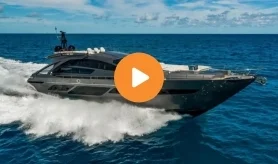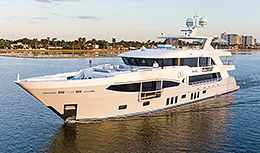- Alaskan Yachts
- Azimut Yachts
- Back Cove Yachts
- Beneteau Yachts
- Benetti Superyachts
- Bertram Yachts
- Boston Whaler
- Broward Yachts
- Buddy Davis Sportfish
- Burger Yachts
- Cabo Yachts
- Catamarans
- Carver Motoryachts
- Center Console
- Chris-Craft Yachts
- Cruisers Yachts
- DeFever Trawlers
- Dufour Sailboats
- Fairline Yachts
- Feadship Yachts
- Ferretti Yachts
- Formula Yachts
- Fountaine Pajot Cats
- Grady-White
- Grand Banks Trawlers
- Hargrave Yachts
- Hatteras Yachts
- Hinckley Picnic Boats
- Horizon Yachts
- Hydra-Sports
- Intrepid Boats
- Jarrett Bay Sportfish
- Jeanneau Yachts
- Kadey-Krogen Trawlers
- Lazzara Yachts
- Lekker Boats
- Luhrs Sportfish
- Marlow Yachts
- Maritimo Yachts
- Marquis Yachts
- Mazu Yachts
- McKinna Motoryachts
- Meridian Yachts
- Midnight Express
- MJM Yachts
- Mochi Craft
- Neptunus Motoryachts
- Nordhavn Trawlers
- Nordic Tugs
- Numarine Yachts
- Ocean Alexander Yachts
- Ocean King
- Offshore Yachts
- Outer Reef
- Oyster Sailing Yachts
- Pacific Mariner Yachts
- Palmer Johnson Yachts
Tips for Operating Foreign-Flagged Vessels in U.S. Waters
Learn the rules to ensure your foreign-flagged yacht can legally operate in the United States.
Updated: November 19, 2020
All operators of a non-commercial small vessel/pleasure boat must report immediately to the nearest U.S. Customs and Border Protection (CBP) Port of Entry upon arriving into the United States (U.S.) from a foreign port or place. EPA enforcement is becoming a more prevalent issue for vessels importing into the U.S. This has been in the regulations for a while and is starting to be enforced. U.S. Customs and Border Protection has started requesting this on a regular basis and, in Miami, Customs is requiring the WPA 3520-21 Engine declaration form be submitted at the time the importation is filed or they will not accept the entry. It requires proof that a vessel’s engines are EPA compliant for the year they were manufactured. In most cases, it’s not too hard to get a manufacturer to get the information that is required if you have the serial number of the motor. Some motors, especially the newer ones, actually have the EPA compliance stickers or plates on the motor itself. This is helpful as it has all the relevant information required.
It’s recommended to have your surveyors look for this information and take pictures of the EPA stickers/plates as part of the valuation survey. With the new Customs enforcement-minded system called ACE, this will be the new normal throughout the U.S. It would be an understatement to say that the rules and regulations of U.S. Customs at ports of entry — and maritime law in general — are incredibly complex. It is hard enough for U.S. flagged vessels to remain compliant with all necessary requirements, but things are far more difficult if you own a foreign-flagged vessel and you’re interested in bringing it to the United States.
The consequences of illegally operating a foreign-flagged vessel in U.S. waters can be dire, so it’s vital that you take the time to understand the U.S. government’s expectations for you and your craft before embarking on your journey. Below are helpful tips to help ensure your foreign-flagged yacht can legally operate in U.S. waters. Keep in mind that COVID-19 travel restrictions may affect these steps and regulations — it’s best to call U.S. Customs and Border Protection with immediate questions.
Report arrival to customs and border protection

Upon entering U.S. territorial waters from a foreign port, the first step you will need to immediately take is to inform Customs of your arrival. U.S. Customs is a part of the Department of Homeland Security, and entry to the United States by land, air, or sea is highly regulated and taken very seriously, so it is absolutely essential that you alert CBP once you arrive.
Once you contact CBP, your vessel will be issued a clearance number that will begin with the four-digit number for your port of entry (Miami – 5201, Fort Lauderdale – 5203, Palm Beach – 5204). Keep this number at all times. It is essential that you enter the Customs house that is located in the port in which you arrived. Keep in mind, no one may board or disembark from the vessel until all Customs processing has been completed, with the exception of disembarking, to alert CBP of your arrival.
Clear crew through immigration

Your next step will be to clear everyone on board the vessel through U.S. immigration. Your crew has 24 hours to clear immigration after reporting your arrival to CBP. Make sure everyone on board has all necessary documentation, such as passports, in order to be granted entry to the U.S. through Immigration. Additionally, all people on board must have obtained a visa prior to arrival that grants them legal access to enter the country.
Formal entry

Once all immigration requirements have been cleared, all foreign-flagged or undocumented vessels must complete a formal entry with Customs using Form CF 1300 — the Vessel Entrance or Clearance Statement. This form can be provided by Customs upon your arrival or you can obtain it online ahead of time.
The vessel must complete formal entry within 48 hours of arriving in the U.S., and you can only do this in the port you arrived at. At this time, the captain will need to notify CBP of any foreign merchandise on board the ship that is subject to duty.
Bring proper documentation

In order to complete your formal entry and legally operate your foreign-flagged vessel in U.S. waters, one of the simplest things you can do is make sure that you and everyone on board the vessel have all necessary documentation.
For example, to complete formal entry, the master of the vessel must provide the ship’s original Certificate of Registry, proof of being foreign, such as clearance from your previous port, and a crew list with the names, birth dates, and passport numbers of everyone on board. Without all the necessary documentation, your trip to the U.S. could be quickly cut short.
Obtain a cruising license

All foreign-flagged vessels are required to obtain a cruising license. This license will allow you to travel from one jurisdiction to another without having to make formal entry or clearance all over again in each new location. If your vessel is eligible, you may be issued your cruising license during your first formal entry, and the license will be valid for up to one year. A first time cruising license also may be issued to a vessel during closing if the closing occurs in U.S. waters and the closing paperwork reflects this fact.
Report arrival in new jurisdictions

Once your formal entry has been approved and you have been granted your cruising license, you may proceed freely to new ports and jurisdictions. The only caveat is that you must alert each new jurisdiction of your arrival. For example, if you enter the U.S. in Miami, and next you proceed to the port at Palm Beach, you will need to call and alert CBP at the port in Palm Beach that you have arrived.
Pay attention to cruising license expiration

Be sure to pay close attention to the expiration date on your cruising license. When it expires, you must surrender your Original Registry to Customs in the jurisdiction the vessel is currently located in. If the boat is U.S.-built and owned by a U.S. citizen or permanent resident, you may be able to obtain a successive cruising license when the old one expires.
However, if you are not eligible for a successive cruising license, you will be required to clear out of Customs to a foreign port for a minimum of 15 days. Once the necessary 15 days have passed, you may return to a U.S. port of entry and once again complete formal entry and apply for a new cruising license. Keep in mind that the 15-day rule can be interpreted differently from port to port, so call ahead and check with the port at which you plan to re-enter the U.S. to find out their exact interpretation of the rule.
Formal clearance and entry for Florida registered, foreign-owned vessels

A somewhat unique situation occurs when a vessel is registered in the state of Florida but not owned by a U.S. citizen or permanent resident. These vessels are NOT considered by CBP to be U.S. flagged, and they take on the nationality of the owner.
So a Florida-registered boat owned by a Canadian citizen would be considered to be an undocumented Canadian vessel with a Florida registry. Unfortunately, these vessels are required to physically clear in and out with Customs every time they make a jurisdictional change using Form 1300. Failure to do so can result in fines of up to $5,000 per infraction.
If you are a foreign-flagged vessel wishing to legally enter and operate in U.S. waters, it can be incredibly difficult to keep track of all of the rules and regulations you must adhere to. Contact a Denison yacht broker for any questions you may have regarding foreign flagged vessels.
Written by: Howard S. Reeder, Inc. is a family-owned business that has been in operation since 1940 when Howard S. Reeder Sr. founded our customs brokerage company and began helping importers bring products into the United States. Now on our third generation of ownership, both our company and our areas of expertise have greatly expanded over the more than 75 years since our inception.






